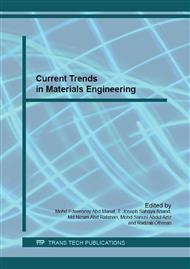p.78
p.83
p.88
p.94
p.101
p.106
p.111
p.116
p.120
Morphology Studies of Electrospun Lithium Iron Phosphate (LiFePO4)/Cellulose Acetate (CA) Fibers
Abstract:
This work was carried out as a preliminary study of electrospun LiFePO4/CA fibers. Cellulose acetate (CA) and LiFePO4 solutions were prepared separately using mixed solvent of acetone and water, prior to the electrospinning process. Then, electrospinning parameters including solution concentration, distance tip to collector, pump rate, and needle diameter size were optimized. Brunauer Emmett Teller (BET) was used to determine the surface area of CA fibers. Viscosity of CA solution was obtained by viscometer. LiFePO4/CA fibers were stabilized and carbonized at different temperature. The surface morphology and microstructure of the obtained LiFePO4/ CA fibers were then characterized using scanning electron microscope (SEM). In this work, it is shown that different electrospinning parameter, solution concentration and solution viscosity gives different fibers diameter and distribution. Moreover, the stabilization and carbonization temperature of LiFePO4/CA fibers may also affect the fibers microstructure.
Info:
Periodical:
Pages:
101-105
Citation:
Online since:
May 2016
Price:
Сopyright:
© 2016 Trans Tech Publications Ltd. All Rights Reserved
Share:
Citation:


